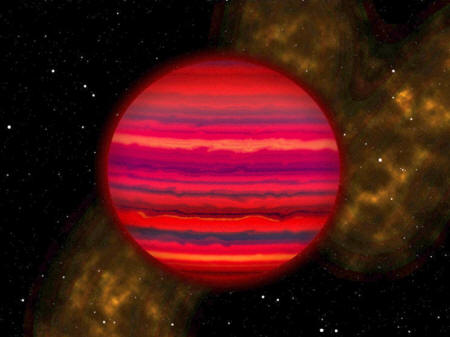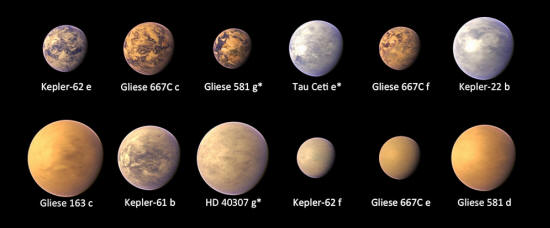|
from
ExtremeTech Website
This week, a team of astronomers led out of UC Santa Cruz released a report on the brown dwarf WISE0855, by far the dimmest object ever imaged in its spectral range.
Their results confirm a preexisting assumption that brown dwarfs ought to be capable of supporting enough water to create phenomena like water clouds.
One frustrating thing about exo-planetology (other than convincing strangers you really do have a job) is the tug of war that goes on between visibility and heat.
The most visible things, when looking for planets, are stars - no life possible on those. The next most visible are usually gas giants, also thought less likely to host life, and after that things basically break down according to heat and light.
With some caveats, the brighter an object is, and thus the easier it is to see from Earth, the hotter it is, and thus the less hospitable to liquid water it becomes.
Artist's rendering of WISE 0855 as it might appear if viewed up close in infrared light. (Illustration by Joy Pollard, Gemini Observatory/AURA)
That's why so-called cold objects are of so much interest to astronomers, because these are the bodies with a low enough temperature to allow not just the existence of liquid water, but an abundance of it.
One very common candidate for such a cool, water-rich body is a brown dwarf - basically, a gas giant that came really close to gathering enough mass to become a star, but which didn't quite make it.
They're larger than a gas giant (sometimes dozens of times heavier than Jupiter) but not quite big enough to spark fusion at their core.
This leaves them quiet and, more importantly, cool enough to allow these formations - and understanding complex water formations is vital to finding life in the universe, or just understanding it in general.
WISE0855 is a brown dwarf lying just 7.2 light years away, making it nice and close by astronomical standards, which is part of what allowed astronomers to collect this information.
Their spectral readings showed an abundance of water vapor and water ice, and major cloud formations covering much of the surface.
The readings were collected by the Gemini-North telescope in Hawaii and the Gemini Near Infrared Spectrograph over 13 nights in a total of about 14 hours of observation.
This is the first time any clouds have been found outside of our solar system, validating several ideas about the nature of water on alien worlds, as well as how generalizable our local planets are to the universe at large.
The team described the formations as "strikingly similar" to Jupiter in many ways, but it does differ in one particularly important way:
Phosphine is a high energy compound formed in the hot center of Jupiter and, presumably, in WISE0855 as well - but phosphine is highly visible in Jupiter's outer atmosphere, owing to the gas giant's turbulent weather, which leads to phosphine from the interior swirling out far enough to be detectable.
The lack of phosphine in WISE0855 suggests it does not experience that same turbulence.
The similarity, however, means that future research could run in both directions, both exoplanets informing our understanding of Jupiter and Jovian science informing our study of exoplanets.
The methodology in finding the cloud cover was simply to sit down a model a bunch of different possible situations on WISE1855, including models with and without clouds of water vapor and ice.
By far the closest fit to their observations were the predictions that assumed the presence of water ice clouds.
The dwarf gives off too little light to be directly visible like a regular star, but its thermal emission is enough that highly specialized infrared light detectors were able to suck up a useful amount of information.
A selection of exoplanets found by NASA's Kepler space observatory.
As mentioned, brown dwarfs are thought to be extremely common in the universe, and though they're not technically stars, they do sometimes have their own planets.
The brown dwarf TRAPPIST-1 was recently shown to host three separate planets, each of which could potentially support life - the low level of light and heat from a brown dwarf dramatically changes the size and location of the habitable zone that surrounds it, but that habitable zone does still exist in most cases.
We worry about so-called "solar storms" the cause increased activity in our own sun.
But this week's study shows that an alien species somewhere else in the universe might inhabit a planet affected by literal storms on its host brown dwarf...
|





